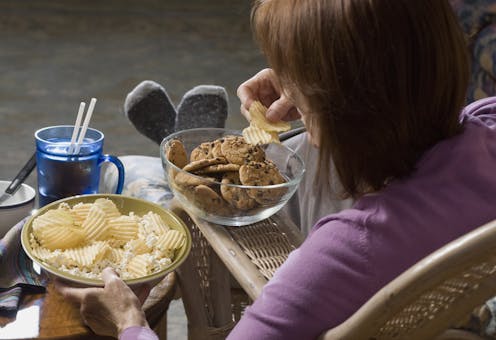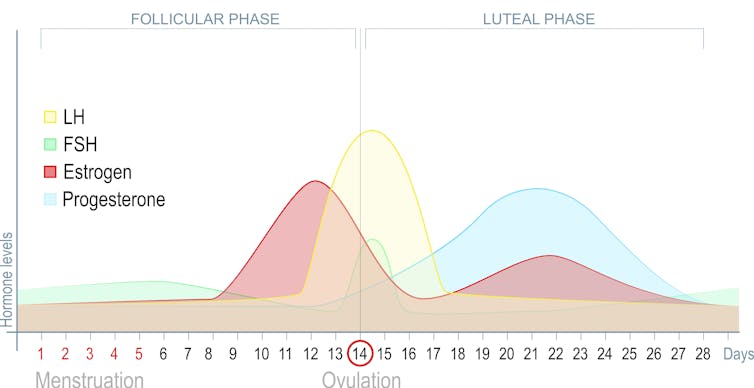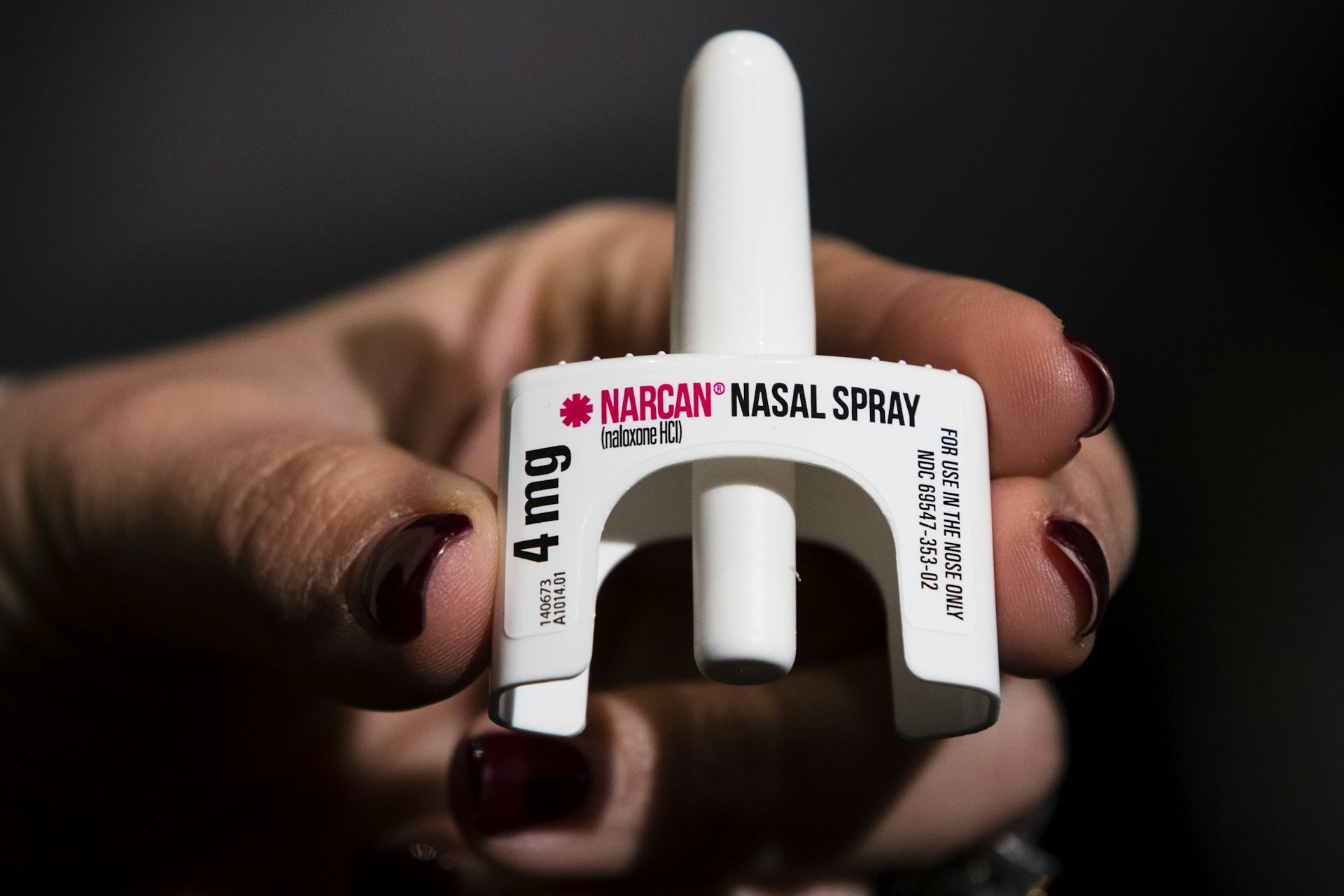Ack! I need chocolate! The science of PMS food cravings
Women might find themselves reaching for sweets and potato chips in the two weeks before their period, even if they don't have a diagnosis of PMS. An OBGYN explains these cyclical food cravings.

Premenstrual food cravings are the punchline of endless jokes. Like most good jokes, they’re funny because they’re true.
Certain parts of a woman’s menstrual cycle do seem to go hand in hand with the desire for chocolate ice cream and potato chips. I hear about this every day from my OBGYN patients.
Researchers have studied food cravings for years; one of the most cited studies dates back to 1953. Scientists – and lots of others – want to know who has food cravings and why, what they crave, when they crave it and how to minimize the cravings. Here’s what the research has found.
Craving and eating before a period
Food cravings are just one of the many symptoms of premenstrual syndrome, also known as PMS. PMS is likely caused by hormonal fluctuations and how they affect chemical messengers in the brain called neurotransmitters. Its symptoms are exclusive to the second half of the menstrual cycle. This luteal phase of the cycle starts with the release of the egg at ovulation and ends when a period begins. The symptoms usually resolve around the third or fourth day of menstruation.

Researchers have documented more than 150 different PMS symptoms in studies, ranging from physical to emotional to behavioral to cognitive. Food cravings are up there with the most commonly reported behavioral PMS symptoms, along with mood swings, irritability, anxiety and tension, and sad or depressed mood.
A woman doesn’t need an official diagnosis of PMS to report hankering for sweets and chocolates, though. Eighty-five percent of women have some sort of perceptible premenstrual symptoms, while only somewhere in the range of 20% to 40% of all women meet the diagnostic criteria for PMS. Researchers find that cravings can occur during that premenstrual time period in normal, healthy individuals without a diagnosis of PMS or other disorder. In fact, one study showed that 97% of all women had previously experienced food cravings – independent of their menstrual cycle.
Research data confirm women tend to eat more during the luteal phase of the menstrual cycle, compared to the follicular phase that leads up to ovulation. With or without the diagnosis of PMS, this increased food intake can be as high as 500 extra calories per day.
What foods are women reaching for? Carbs and fats and sweets. No surprise there. The most commonly reported food craving is chocolate, likely because it’s a pleasantly sweet combination of carbs and fat.
And although the existence of any craving is similar across women with and without PMS, the craving itself may differ depending on if you have the diagnosis of PMS. In one study, women without PMS increased their intake of energy and fat, while women with PMS showed increase in total energy and all macronutrients.
What causes food cravings?
Researchers aren’t exactly sure where these food cravings come from, but there are several leading theories.

One idea is that women are unconsciously using food as a pharmacological therapy. Many studies show that women in their luteal phase crave more carbohydrates compared to during their follicular phase. Eating carbs turns up levels of serotonin, a neurotransmitter in the central nervous system, which contributes to a general sense of well-being and happiness. By increasing carb intake, women may be self-medicating with food to cause that serotonin bump in order to feel better. In one study, when researchers increased serotonin neurotransmission in the brain, either through diet or drugs, people’s food intake and mood went back to normal.
Another possible explanation for food cravings suggests that women intentionally turn to food for physical and psychological comfort. Food can play a sensory role, eliminating any uncomfortable feeling of hunger while tasting good and feeling pleasant to eat. Researchers find that “thinking” of a really tasty food is the most common provocation for wanting to consume it and that cravings are not solely hunger driven. Women also usually reported specific triggers for thinking of comforting food, like boredom or stress, further promoting the idea that the comfort of food helps mitigate unpleasant feelings – as one might experience with PMS.
Other researchers suggest that these food cravings are regulated by hormones. Scientists have observed that women tend to eat more when estrogen levels are low and progesterone levels are high – as occurs during the luteal phase. The reverse pattern is seen in rats during the follicular phase, when estrogen levels are high and progesterone levels are low. The fact that progesterone-only forms of contraception like Depo Provera are associated with weight gain, likely due to increased appetite, supports this theory as well.
How can you get rid of monthly cravings?
My general advice to women: be knowledgeable about your own body and how it changes in response to your monthly cycle. Your experience is different than your best friend’s. Being in touch with your symptoms can help you acknowledge that they are normal for you at this point in time instead of worrying whether they’re weird. If you feel unsure, ask your gynecologist.

Lifestyle changes can help balance and minimize unwanted symptoms related to your menstrual cycle. Things to try include regular exercise, relaxation and stress reduction techniques such as breathing exercises, yoga, meditation, massage, self-hypnosis and regular, good sleep.
Cognitive behavioral therapy and biofeedback may be options. They usually require support of a therapist or counselor to be most effective.
And you can optimize your diet to fight cravings:
- Choose complex carbohydrates, including whole grains, brown rice, barley, beans and lentils. Choose whole wheat over white flour.
- Reduce fat, salt and sugar – all of which can leave you craving more.
- Minimize or avoid caffeine and alcohol.
- Eat more calcium-rich foods, including green leafy vegetables and dairy. One study showed women who consumed milk, cheese and yogurt had less abdominal bloating, cramps, appetite and cravings for some foods, possibly because the calcium they contain helped reverse an imbalance of feel-good serotonin. Women who are sensitive to dairy can take a calcium supplement of 1200 mg daily.
- Try magnesium supplements. This mineral can help reduce water retention and bloating, breast tenderness and mood symptoms.
- Vitamin B6 (50 mg daily), in addition to magnesium, may have some benefit as well.
- Vitamin E (150-300 IU daily) may be helpful to reduce cravings.
When food cravings are part of a PMS diagnosis, treatment for premenstrual syndrome in general may help minimize them.
Sara Twogood does not work for, consult, own shares in or receive funding from any company or organisation that would benefit from this article, and has disclosed no relevant affiliations beyond their academic appointment.
Read These Next
Drones, physics and rats: Studies show how the people of Rapa Nui made and moved the giant statues –
The mysteries of Easter Island, subjects of speculation for centuries, yield to scientific inquiry.
As US hunger rises, Trump administration’s ‘efficiency’ goals cause massive food waste
Despite the administration’s claim of streamlining the government to make its operations more efficient,…
Absence of evidence is not evidence of absence – and that affects what scientific journals choose to
Researchers design studies that might disprove what’s called their null hypothesis – the opposite…





